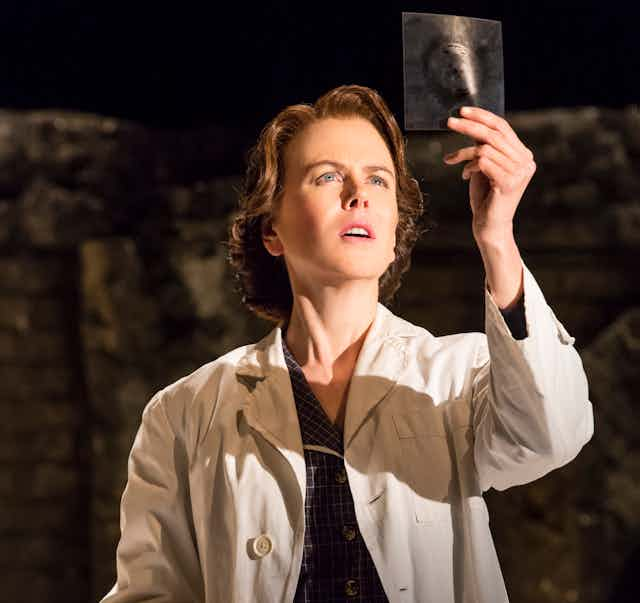Photograph 51 is causing a stir in London (running through November at the Noel Coward Theatre) – and not just because the star of the show is Nicole Kidman. It’s also because of the gripping scientific story Anna Ziegler’s new play tells.
Kidman plays Rosalind Franklin, the scientist whose crystallography work helped Watson and Crick discover DNA, but who never received the recognition she deserved. In particular, her 51st photograph confirmed their hypothesis that the structure of DNA had to be a double helix. Until then they lacked this crucial evidence for their theory.
The production has been hailed by critics: in the New York Times Ben Brantley calls Kidman “pretty close to perfection” while Michael Billington in the Guardian wishes this “intriguing, informative 95-minute play” were longer. In many ways, it is an all-too-familiar tale: a woman working in a field dominated by men whose work was not given proper credit – a tragic figure who died too young (Franklin died of ovarian cancer at age 38).
Science on stage
Photograph 51 is one of several new “science plays” to have appeared this year (although it was first produced off Broadway five years ago, to positive reviews but to relatively little attention). In January, Tom Stoppard’s The Hard Problem played at the National Theatre, sold out for its entire run. This latest drama of ideas from the author of Arcadia (1993) is set in a well-funded institute for brain research and explores such questions as whether there is a neural basis for consciousness and whether humans are hard-wired for altruism.
The Hard Problem overlapped with Tom Morton-Smith’s Oppenheimer. That play explored J Robert Oppenheimer’s rise to prominence as leader of the Manhattan Project and his complex network of relationships with fellow physicists, the US military and his family and friends. Among other things, it probed the motives and ethics of using atomic bombs at Hiroshima and Nagasaki, questions that continue to haunt us 70 years on.
And yet another new science play, Informed Consent by Deborah Zoe Laufer, has just finished a successful run in New York. Based on real events, it explores the complex ethical issues arising from a genetic anthropologist’s research on the gene pool in an isolated Native American tribe in the Grand Canyon. Like Photograph 51, The Hard Problem and Shelagh Stephenson’s 1998 play An Experiment with an Air-Pump, Informed Consent features a female scientist and centres on the science and wider implications of genetics.

Popular science
So Photograph 51 closes out a bumper year for science in the theatre, especially plays by women and about female scientists. It also raises the question of what makes a successful science play. One of the central issues, raised most prominently by Michael Frayn’s 1998 play Copenhagen, is fidelity to historical events and people, such as Franklin, Oppenheimer, Bohr and Heisenberg.
What was Rosalind Franklin really like? Kidman’s portrayal of her exudes iron will and self-control. Her fellow scientists find her, as Brantley puts it: “exacting, humourless, brilliant and disciplined to the point of rigidity” – an intimidating and relentless perfectionist. But the Franklin family have claimed that although they’re pleased about the play’s public righting of the wrong done to her, the play misrepresents her personality. They also say it exaggerates the extent to which Franklin was a bold feminist pioneer. Scientific accuracy is also a contentious issue and is the subject of much debate between scientists and theatre makers.
What is common to science plays is the relentless search for knowledge – and this is key to their attraction for audiences. One of the central themes of Copenhagen and of Stoppard’s Arcadia is the importance of “wanting to know”, something that also comes across forcefully in Photograph 51. Kidman’s face as she studies the revelatory photograph exudes the thrill of discovery, of those eureka moments of science that make all the hard work, tedious repetition, and failure worth it.
Interestingly, that photograph is never shown to the audience, although it is reprinted in the programme. What the audience does see on stage is a post-war landscape strewn with rubble: a stark visual reminder of the circumstances in which these groundbreaking scientific advances are taking place.
Why now?
Although “science plays” have a long history, there is a particularly strong interest in putting science on stage right now. This is perhaps because there is a greater sense of urgency about what science can do, both for good and evil. As Oppenheimer (and its predecessor, a 1964 documentary play by Heinar Kipphardt about Oppenheimer) reminds us, World War II and the Cold War made it clear in an unprecedented way that science can have dire repercussions. Therefore, we all have an obligation to understand that and we all have a stake in it, not just the scientists and their funders.
And the way that we have access to seemingly endless information on medical issues, scientific findings and their implications on the internet has also helped science to burst the bounds of the laboratory.
Equally, the rise of “public engagement” initiatives has not just encouraged, but mandated scientists to speak to the public about their work. Many contemporary “science plays” are the result of new funding initiatives to enable public engagement, for instance by the Wellcome Trust and the Alfred P. Sloan Foundation in America, which helped to fund Informed Consent, for example.
As new areas of science open up, so too will new “science plays” emerge. Currently, climate change is enjoying an outing on the stage, with a spate of new productions dealing with global warming and its consequences. Who knows what will be next.

